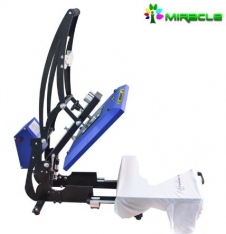
The features and analysis of sublimation heat transfer technology
The features and analysis of sublimation heat transfer technology
Description
Features of sublimation heat transfer
Simply speaking, sublimation heat transfer is to firstly print the disperse dye (or sublimation ink) onto the specific paper by machine, and then transfer the printed images into specific materials by high temperature and high pressure.subli-mateHowever, with the rapid development of technology, some refinement in this field has been done to stimulate heat transfer business emergence in an endless stream. The most prominent is that with the same transfer carrier, but printing dispersed dyes by gravure press is the main printing method.
Analysis of sublimation heat transfer technology
According to the demand of heat transfer market, multifunctional printing methods are as follow:
1. Sublimation heat transfer —— Transfer Paper
Transfer paper is to disperse dyes by gravure press machine.
Advantages : low cost, fine and full pattern expression, strong sense of hierarchy, suitable for mass production.
Disadvantages : high mold charge, lack of competitiveness for small quantities for personalized business.
2. Sublimation —— Offset printing
Firstly the offset press machine offset sublimation inks. Secondly, the printer print the sublimation inks onto the paper. After drying naturally, printed images is transferred onto the specific textiles.
Advantages: because of using the ps printing technology, it is low mold charge, low cost and suitable for small productions.
Disadvantages: it is hard to control the color of the finished works.
3. Sublimation —— Digital heat transfer technology
Advantages: the finest and fullest pattern expression,i-transfer stronger sense of hierarchy, without problems of color and plug version.
Disadvantages:high cost of sublimation ink and paper, just suitable for small productions.
4. Sublimation—— Silk printing
Advantages:low cost of sublimation ink and low mold charge.
Disadvantages: it is not suitable for printing character, landscape pattern because burrs is common in the edge of images.
Simply speaking, sublimation heat transfer is to firstly print the disperse dye (or sublimation ink) onto the specific paper by machine, and then transfer the printed images into specific materials by high temperature and high pressure.subli-mateHowever, with the rapid development of technology, some refinement in this field has been done to stimulate heat transfer business emergence in an endless stream. The most prominent is that with the same transfer carrier, but printing dispersed dyes by gravure press is the main printing method.
Analysis of sublimation heat transfer technology
According to the demand of heat transfer market, multifunctional printing methods are as follow:
1. Sublimation heat transfer —— Transfer Paper
Transfer paper is to disperse dyes by gravure press machine.
Advantages : low cost, fine and full pattern expression, strong sense of hierarchy, suitable for mass production.
Disadvantages : high mold charge, lack of competitiveness for small quantities for personalized business.
2. Sublimation —— Offset printing
Firstly the offset press machine offset sublimation inks. Secondly, the printer print the sublimation inks onto the paper. After drying naturally, printed images is transferred onto the specific textiles.
Advantages: because of using the ps printing technology, it is low mold charge, low cost and suitable for small productions.
Disadvantages: it is hard to control the color of the finished works.
3. Sublimation —— Digital heat transfer technology
Advantages: the finest and fullest pattern expression,i-transfer stronger sense of hierarchy, without problems of color and plug version.
Disadvantages:high cost of sublimation ink and paper, just suitable for small productions.
4. Sublimation—— Silk printing
Advantages:low cost of sublimation ink and low mold charge.
Disadvantages: it is not suitable for printing character, landscape pattern because burrs is common in the edge of images.








